LDT3105: Managing Projects - Employee Benefits Impact at Tesco
VerifiedAdded on 2023/06/12
|8
|1923
|454
Report
AI Summary
This report examines the impact of employee benefits on worker productivity within Tesco, aligning with the LDT3105 Managing Projects for Competitive Success module. The study outlines the project's aims and objectives, focusing on the influence of personnel advantages on Tesco's operational performance and overall job efficiency. It details a project management plan, including a Work Breakdown Structure (WBS) and Gantt chart, and evaluates the usefulness, strengths, and weaknesses of project planning tools like Gantt charts and WBS. The report further applies a risk management process, identifying, assessing, treating, and monitoring potential risks and opportunities within the project, emphasizing the importance of communication and continuous monitoring for successful project implementation. The research concludes by highlighting the significance of managing employee well-being to enhance productivity and performance within the organization.
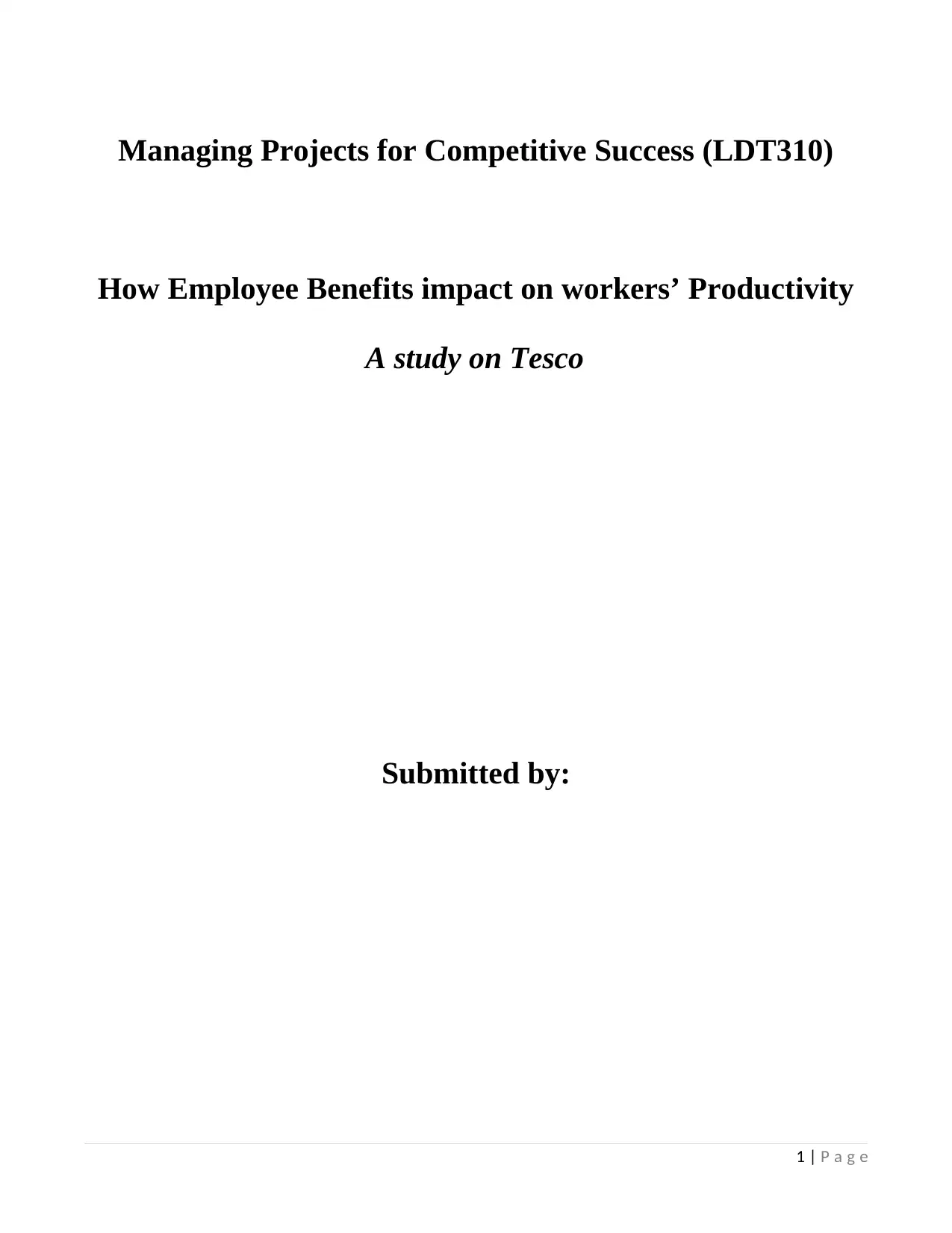
Managing Projects for Competitive Success (LDT310)
How Employee Benefits impact on workers’ Productivity
A study on Tesco
Submitted by:
1 | P a g e
How Employee Benefits impact on workers’ Productivity
A study on Tesco
Submitted by:
1 | P a g e
Paraphrase This Document
Need a fresh take? Get an instant paraphrase of this document with our AI Paraphraser
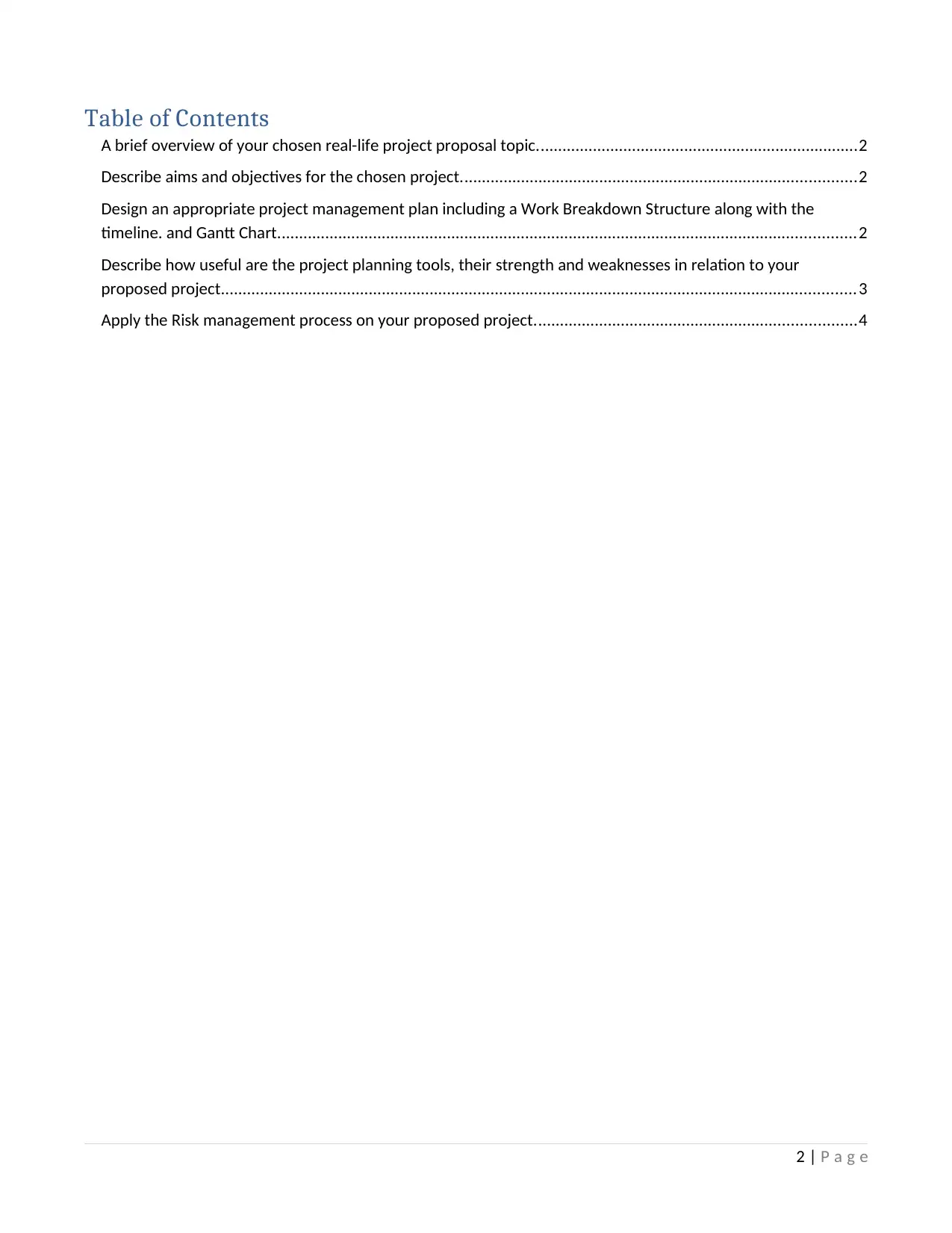
Table of Contents
A brief overview of your chosen real-life project proposal topic..........................................................................2
Describe aims and objectives for the chosen project...........................................................................................2
Design an appropriate project management plan including a Work Breakdown Structure along with the
timeline. and Gantt Chart.....................................................................................................................................2
Describe how useful are the project planning tools, their strength and weaknesses in relation to your
proposed project..................................................................................................................................................3
Apply the Risk management process on your proposed project..........................................................................4
2 | P a g e
A brief overview of your chosen real-life project proposal topic..........................................................................2
Describe aims and objectives for the chosen project...........................................................................................2
Design an appropriate project management plan including a Work Breakdown Structure along with the
timeline. and Gantt Chart.....................................................................................................................................2
Describe how useful are the project planning tools, their strength and weaknesses in relation to your
proposed project..................................................................................................................................................3
Apply the Risk management process on your proposed project..........................................................................4
2 | P a g e
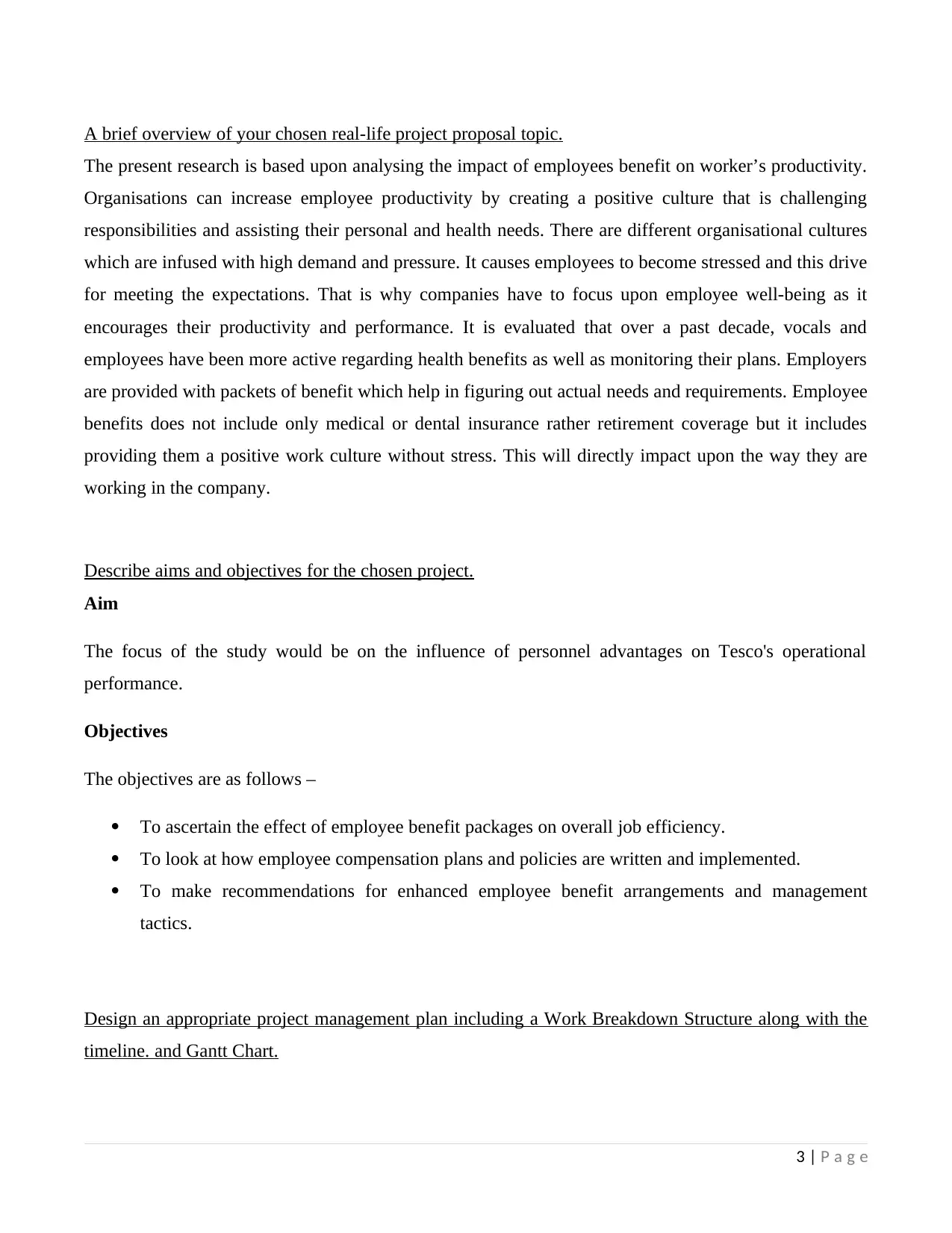
A brief overview of your chosen real-life project proposal topic.
The present research is based upon analysing the impact of employees benefit on worker’s productivity.
Organisations can increase employee productivity by creating a positive culture that is challenging
responsibilities and assisting their personal and health needs. There are different organisational cultures
which are infused with high demand and pressure. It causes employees to become stressed and this drive
for meeting the expectations. That is why companies have to focus upon employee well-being as it
encourages their productivity and performance. It is evaluated that over a past decade, vocals and
employees have been more active regarding health benefits as well as monitoring their plans. Employers
are provided with packets of benefit which help in figuring out actual needs and requirements. Employee
benefits does not include only medical or dental insurance rather retirement coverage but it includes
providing them a positive work culture without stress. This will directly impact upon the way they are
working in the company.
Describe aims and objectives for the chosen project.
Aim
The focus of the study would be on the influence of personnel advantages on Tesco's operational
performance.
Objectives
The objectives are as follows –
To ascertain the effect of employee benefit packages on overall job efficiency.
To look at how employee compensation plans and policies are written and implemented.
To make recommendations for enhanced employee benefit arrangements and management
tactics.
Design an appropriate project management plan including a Work Breakdown Structure along with the
timeline. and Gantt Chart.
3 | P a g e
The present research is based upon analysing the impact of employees benefit on worker’s productivity.
Organisations can increase employee productivity by creating a positive culture that is challenging
responsibilities and assisting their personal and health needs. There are different organisational cultures
which are infused with high demand and pressure. It causes employees to become stressed and this drive
for meeting the expectations. That is why companies have to focus upon employee well-being as it
encourages their productivity and performance. It is evaluated that over a past decade, vocals and
employees have been more active regarding health benefits as well as monitoring their plans. Employers
are provided with packets of benefit which help in figuring out actual needs and requirements. Employee
benefits does not include only medical or dental insurance rather retirement coverage but it includes
providing them a positive work culture without stress. This will directly impact upon the way they are
working in the company.
Describe aims and objectives for the chosen project.
Aim
The focus of the study would be on the influence of personnel advantages on Tesco's operational
performance.
Objectives
The objectives are as follows –
To ascertain the effect of employee benefit packages on overall job efficiency.
To look at how employee compensation plans and policies are written and implemented.
To make recommendations for enhanced employee benefit arrangements and management
tactics.
Design an appropriate project management plan including a Work Breakdown Structure along with the
timeline. and Gantt Chart.
3 | P a g e
⊘ This is a preview!⊘
Do you want full access?
Subscribe today to unlock all pages.

Trusted by 1+ million students worldwide
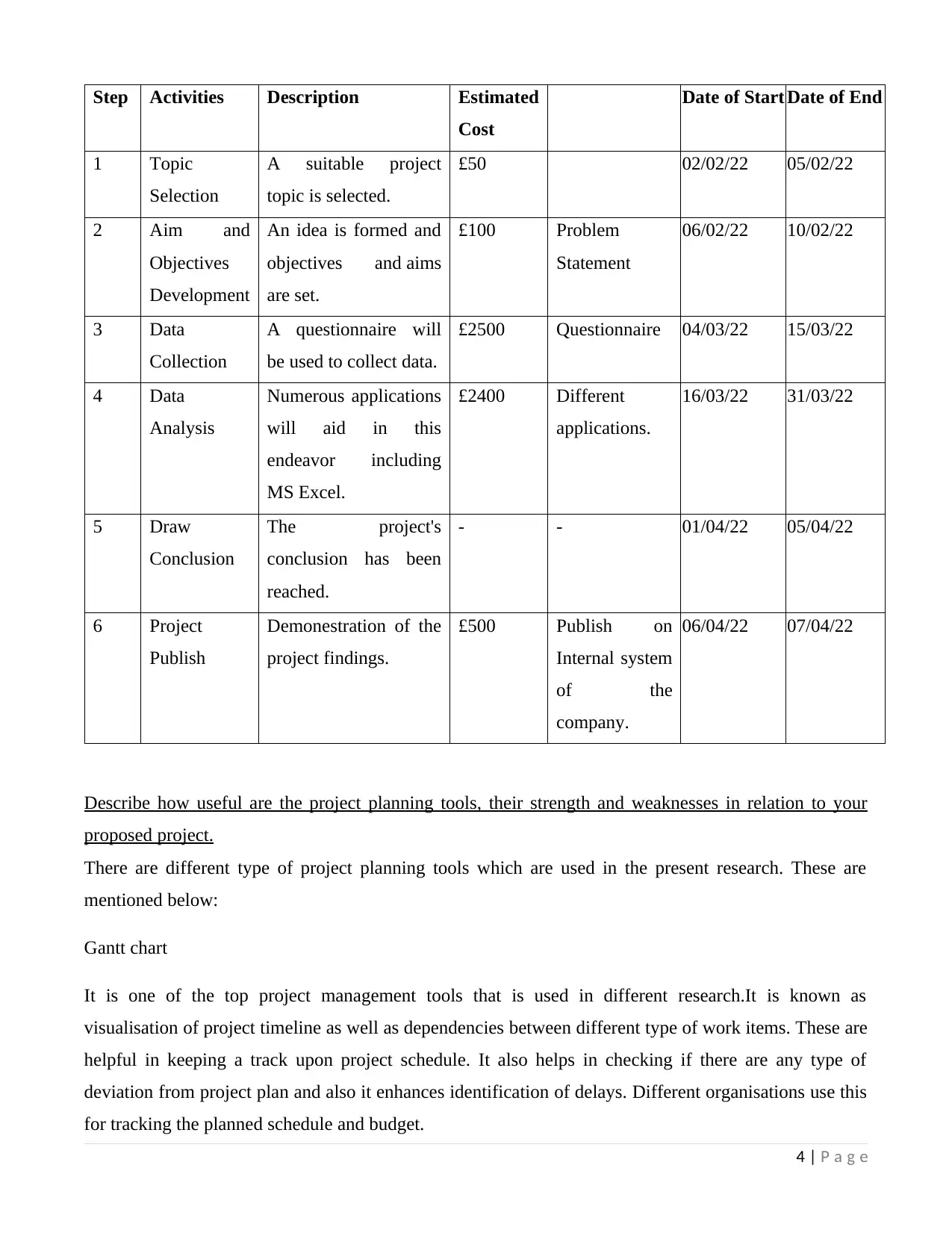
Step Activities Description Estimated
Cost
Date of Start Date of End
1 Topic
Selection
A suitable project
topic is selected.
£50 02/02/22 05/02/22
2 Aim and
Objectives
Development
An idea is formed and
objectives and aims
are set.
£100 Problem
Statement
06/02/22 10/02/22
3 Data
Collection
A questionnaire will
be used to collect data.
£2500 Questionnaire 04/03/22 15/03/22
4 Data
Analysis
Numerous applications
will aid in this
endeavor including
MS Excel.
£2400 Different
applications.
16/03/22 31/03/22
5 Draw
Conclusion
The project's
conclusion has been
reached.
- - 01/04/22 05/04/22
6 Project
Publish
Demonestration of the
project findings.
£500 Publish on
Internal system
of the
company.
06/04/22 07/04/22
Describe how useful are the project planning tools, their strength and weaknesses in relation to your
proposed project.
There are different type of project planning tools which are used in the present research. These are
mentioned below:
Gantt chart
It is one of the top project management tools that is used in different research.It is known as
visualisation of project timeline as well as dependencies between different type of work items. These are
helpful in keeping a track upon project schedule. It also helps in checking if there are any type of
deviation from project plan and also it enhances identification of delays. Different organisations use this
for tracking the planned schedule and budget.
4 | P a g e
Cost
Date of Start Date of End
1 Topic
Selection
A suitable project
topic is selected.
£50 02/02/22 05/02/22
2 Aim and
Objectives
Development
An idea is formed and
objectives and aims
are set.
£100 Problem
Statement
06/02/22 10/02/22
3 Data
Collection
A questionnaire will
be used to collect data.
£2500 Questionnaire 04/03/22 15/03/22
4 Data
Analysis
Numerous applications
will aid in this
endeavor including
MS Excel.
£2400 Different
applications.
16/03/22 31/03/22
5 Draw
Conclusion
The project's
conclusion has been
reached.
- - 01/04/22 05/04/22
6 Project
Publish
Demonestration of the
project findings.
£500 Publish on
Internal system
of the
company.
06/04/22 07/04/22
Describe how useful are the project planning tools, their strength and weaknesses in relation to your
proposed project.
There are different type of project planning tools which are used in the present research. These are
mentioned below:
Gantt chart
It is one of the top project management tools that is used in different research.It is known as
visualisation of project timeline as well as dependencies between different type of work items. These are
helpful in keeping a track upon project schedule. It also helps in checking if there are any type of
deviation from project plan and also it enhances identification of delays. Different organisations use this
for tracking the planned schedule and budget.
4 | P a g e
Paraphrase This Document
Need a fresh take? Get an instant paraphrase of this document with our AI Paraphraser
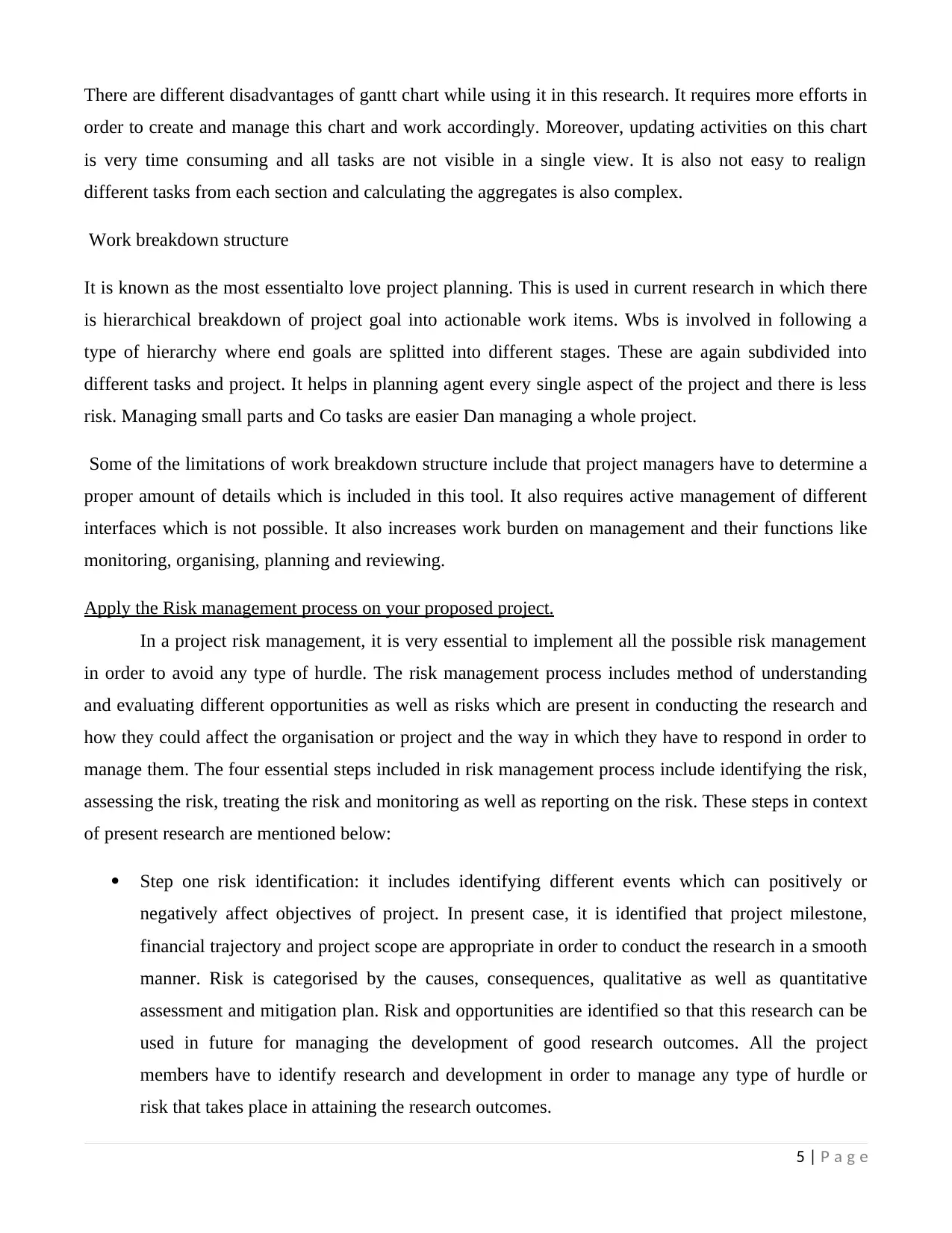
There are different disadvantages of gantt chart while using it in this research. It requires more efforts in
order to create and manage this chart and work accordingly. Moreover, updating activities on this chart
is very time consuming and all tasks are not visible in a single view. It is also not easy to realign
different tasks from each section and calculating the aggregates is also complex.
Work breakdown structure
It is known as the most essentialto love project planning. This is used in current research in which there
is hierarchical breakdown of project goal into actionable work items. Wbs is involved in following a
type of hierarchy where end goals are splitted into different stages. These are again subdivided into
different tasks and project. It helps in planning agent every single aspect of the project and there is less
risk. Managing small parts and Co tasks are easier Dan managing a whole project.
Some of the limitations of work breakdown structure include that project managers have to determine a
proper amount of details which is included in this tool. It also requires active management of different
interfaces which is not possible. It also increases work burden on management and their functions like
monitoring, organising, planning and reviewing.
Apply the Risk management process on your proposed project.
In a project risk management, it is very essential to implement all the possible risk management
in order to avoid any type of hurdle. The risk management process includes method of understanding
and evaluating different opportunities as well as risks which are present in conducting the research and
how they could affect the organisation or project and the way in which they have to respond in order to
manage them. The four essential steps included in risk management process include identifying the risk,
assessing the risk, treating the risk and monitoring as well as reporting on the risk. These steps in context
of present research are mentioned below:
Step one risk identification: it includes identifying different events which can positively or
negatively affect objectives of project. In present case, it is identified that project milestone,
financial trajectory and project scope are appropriate in order to conduct the research in a smooth
manner. Risk is categorised by the causes, consequences, qualitative as well as quantitative
assessment and mitigation plan. Risk and opportunities are identified so that this research can be
used in future for managing the development of good research outcomes. All the project
members have to identify research and development in order to manage any type of hurdle or
risk that takes place in attaining the research outcomes.
5 | P a g e
order to create and manage this chart and work accordingly. Moreover, updating activities on this chart
is very time consuming and all tasks are not visible in a single view. It is also not easy to realign
different tasks from each section and calculating the aggregates is also complex.
Work breakdown structure
It is known as the most essentialto love project planning. This is used in current research in which there
is hierarchical breakdown of project goal into actionable work items. Wbs is involved in following a
type of hierarchy where end goals are splitted into different stages. These are again subdivided into
different tasks and project. It helps in planning agent every single aspect of the project and there is less
risk. Managing small parts and Co tasks are easier Dan managing a whole project.
Some of the limitations of work breakdown structure include that project managers have to determine a
proper amount of details which is included in this tool. It also requires active management of different
interfaces which is not possible. It also increases work burden on management and their functions like
monitoring, organising, planning and reviewing.
Apply the Risk management process on your proposed project.
In a project risk management, it is very essential to implement all the possible risk management
in order to avoid any type of hurdle. The risk management process includes method of understanding
and evaluating different opportunities as well as risks which are present in conducting the research and
how they could affect the organisation or project and the way in which they have to respond in order to
manage them. The four essential steps included in risk management process include identifying the risk,
assessing the risk, treating the risk and monitoring as well as reporting on the risk. These steps in context
of present research are mentioned below:
Step one risk identification: it includes identifying different events which can positively or
negatively affect objectives of project. In present case, it is identified that project milestone,
financial trajectory and project scope are appropriate in order to conduct the research in a smooth
manner. Risk is categorised by the causes, consequences, qualitative as well as quantitative
assessment and mitigation plan. Risk and opportunities are identified so that this research can be
used in future for managing the development of good research outcomes. All the project
members have to identify research and development in order to manage any type of hurdle or
risk that takes place in attaining the research outcomes.
5 | P a g e
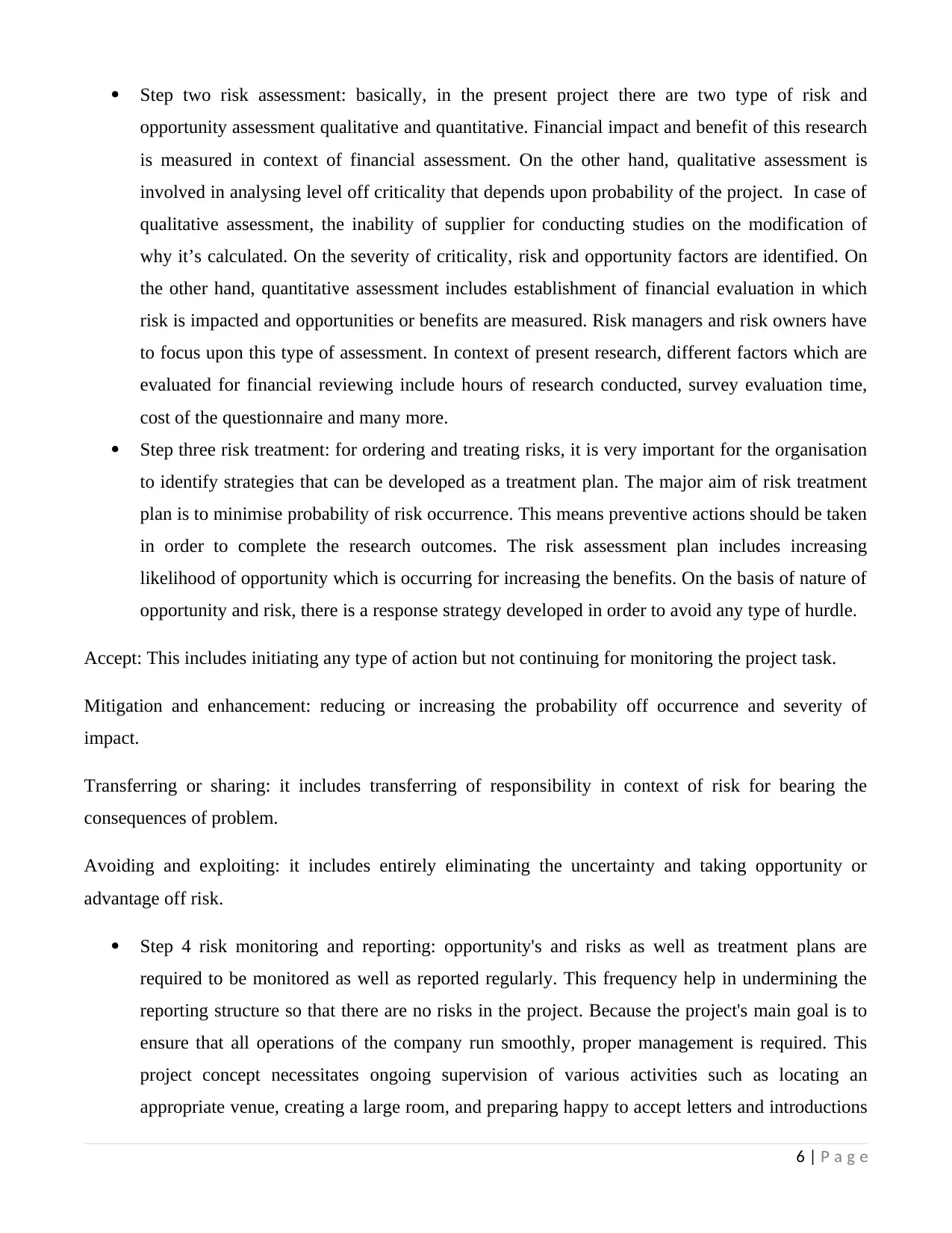
Step two risk assessment: basically, in the present project there are two type of risk and
opportunity assessment qualitative and quantitative. Financial impact and benefit of this research
is measured in context of financial assessment. On the other hand, qualitative assessment is
involved in analysing level off criticality that depends upon probability of the project. In case of
qualitative assessment, the inability of supplier for conducting studies on the modification of
why it’s calculated. On the severity of criticality, risk and opportunity factors are identified. On
the other hand, quantitative assessment includes establishment of financial evaluation in which
risk is impacted and opportunities or benefits are measured. Risk managers and risk owners have
to focus upon this type of assessment. In context of present research, different factors which are
evaluated for financial reviewing include hours of research conducted, survey evaluation time,
cost of the questionnaire and many more.
Step three risk treatment: for ordering and treating risks, it is very important for the organisation
to identify strategies that can be developed as a treatment plan. The major aim of risk treatment
plan is to minimise probability of risk occurrence. This means preventive actions should be taken
in order to complete the research outcomes. The risk assessment plan includes increasing
likelihood of opportunity which is occurring for increasing the benefits. On the basis of nature of
opportunity and risk, there is a response strategy developed in order to avoid any type of hurdle.
Accept: This includes initiating any type of action but not continuing for monitoring the project task.
Mitigation and enhancement: reducing or increasing the probability off occurrence and severity of
impact.
Transferring or sharing: it includes transferring of responsibility in context of risk for bearing the
consequences of problem.
Avoiding and exploiting: it includes entirely eliminating the uncertainty and taking opportunity or
advantage off risk.
Step 4 risk monitoring and reporting: opportunity's and risks as well as treatment plans are
required to be monitored as well as reported regularly. This frequency help in undermining the
reporting structure so that there are no risks in the project. Because the project's main goal is to
ensure that all operations of the company run smoothly, proper management is required. This
project concept necessitates ongoing supervision of various activities such as locating an
appropriate venue, creating a large room, and preparing happy to accept letters and introductions
6 | P a g e
opportunity assessment qualitative and quantitative. Financial impact and benefit of this research
is measured in context of financial assessment. On the other hand, qualitative assessment is
involved in analysing level off criticality that depends upon probability of the project. In case of
qualitative assessment, the inability of supplier for conducting studies on the modification of
why it’s calculated. On the severity of criticality, risk and opportunity factors are identified. On
the other hand, quantitative assessment includes establishment of financial evaluation in which
risk is impacted and opportunities or benefits are measured. Risk managers and risk owners have
to focus upon this type of assessment. In context of present research, different factors which are
evaluated for financial reviewing include hours of research conducted, survey evaluation time,
cost of the questionnaire and many more.
Step three risk treatment: for ordering and treating risks, it is very important for the organisation
to identify strategies that can be developed as a treatment plan. The major aim of risk treatment
plan is to minimise probability of risk occurrence. This means preventive actions should be taken
in order to complete the research outcomes. The risk assessment plan includes increasing
likelihood of opportunity which is occurring for increasing the benefits. On the basis of nature of
opportunity and risk, there is a response strategy developed in order to avoid any type of hurdle.
Accept: This includes initiating any type of action but not continuing for monitoring the project task.
Mitigation and enhancement: reducing or increasing the probability off occurrence and severity of
impact.
Transferring or sharing: it includes transferring of responsibility in context of risk for bearing the
consequences of problem.
Avoiding and exploiting: it includes entirely eliminating the uncertainty and taking opportunity or
advantage off risk.
Step 4 risk monitoring and reporting: opportunity's and risks as well as treatment plans are
required to be monitored as well as reported regularly. This frequency help in undermining the
reporting structure so that there are no risks in the project. Because the project's main goal is to
ensure that all operations of the company run smoothly, proper management is required. This
project concept necessitates ongoing supervision of various activities such as locating an
appropriate venue, creating a large room, and preparing happy to accept letters and introductions
6 | P a g e
⊘ This is a preview!⊘
Do you want full access?
Subscribe today to unlock all pages.

Trusted by 1+ million students worldwide
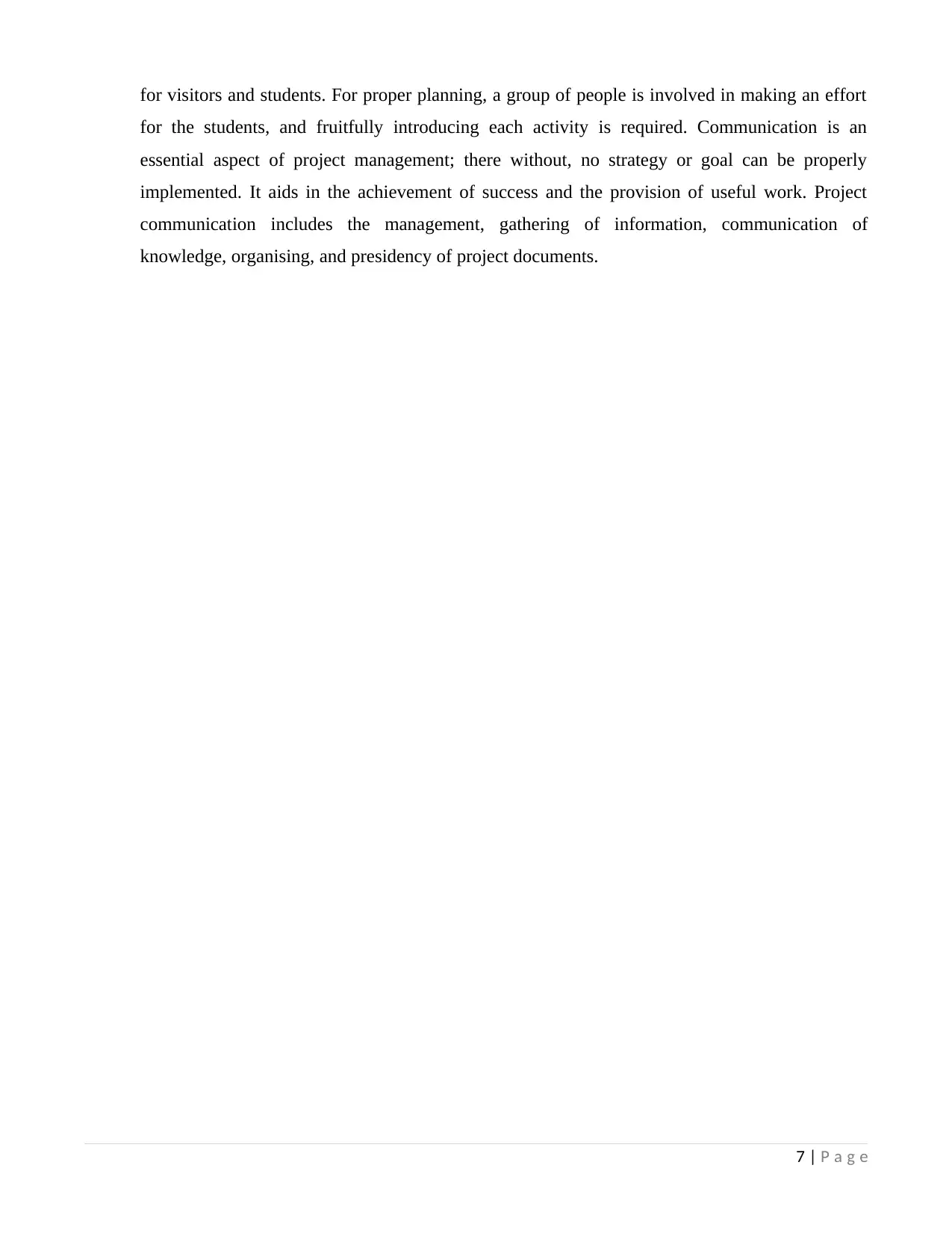
for visitors and students. For proper planning, a group of people is involved in making an effort
for the students, and fruitfully introducing each activity is required. Communication is an
essential aspect of project management; there without, no strategy or goal can be properly
implemented. It aids in the achievement of success and the provision of useful work. Project
communication includes the management, gathering of information, communication of
knowledge, organising, and presidency of project documents.
7 | P a g e
for the students, and fruitfully introducing each activity is required. Communication is an
essential aspect of project management; there without, no strategy or goal can be properly
implemented. It aids in the achievement of success and the provision of useful work. Project
communication includes the management, gathering of information, communication of
knowledge, organising, and presidency of project documents.
7 | P a g e
Paraphrase This Document
Need a fresh take? Get an instant paraphrase of this document with our AI Paraphraser
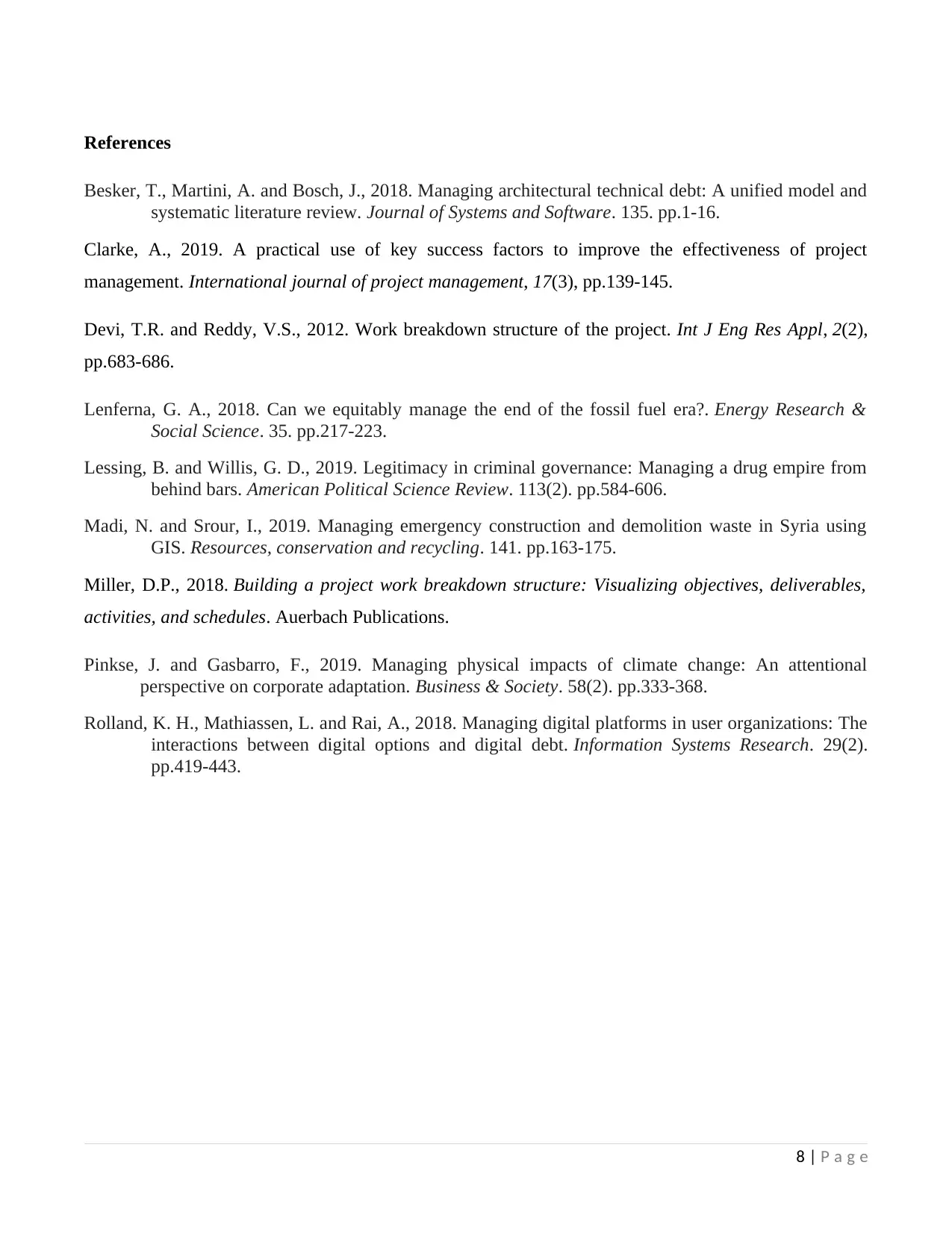
References
Besker, T., Martini, A. and Bosch, J., 2018. Managing architectural technical debt: A unified model and
systematic literature review. Journal of Systems and Software. 135. pp.1-16.
Clarke, A., 2019. A practical use of key success factors to improve the effectiveness of project
management. International journal of project management, 17(3), pp.139-145.
Devi, T.R. and Reddy, V.S., 2012. Work breakdown structure of the project. Int J Eng Res Appl, 2(2),
pp.683-686.
Lenferna, G. A., 2018. Can we equitably manage the end of the fossil fuel era?. Energy Research &
Social Science. 35. pp.217-223.
Lessing, B. and Willis, G. D., 2019. Legitimacy in criminal governance: Managing a drug empire from
behind bars. American Political Science Review. 113(2). pp.584-606.
Madi, N. and Srour, I., 2019. Managing emergency construction and demolition waste in Syria using
GIS. Resources, conservation and recycling. 141. pp.163-175.
Miller, D.P., 2018. Building a project work breakdown structure: Visualizing objectives, deliverables,
activities, and schedules. Auerbach Publications.
Pinkse, J. and Gasbarro, F., 2019. Managing physical impacts of climate change: An attentional
perspective on corporate adaptation. Business & Society. 58(2). pp.333-368.
Rolland, K. H., Mathiassen, L. and Rai, A., 2018. Managing digital platforms in user organizations: The
interactions between digital options and digital debt. Information Systems Research. 29(2).
pp.419-443.
8 | P a g e
Besker, T., Martini, A. and Bosch, J., 2018. Managing architectural technical debt: A unified model and
systematic literature review. Journal of Systems and Software. 135. pp.1-16.
Clarke, A., 2019. A practical use of key success factors to improve the effectiveness of project
management. International journal of project management, 17(3), pp.139-145.
Devi, T.R. and Reddy, V.S., 2012. Work breakdown structure of the project. Int J Eng Res Appl, 2(2),
pp.683-686.
Lenferna, G. A., 2018. Can we equitably manage the end of the fossil fuel era?. Energy Research &
Social Science. 35. pp.217-223.
Lessing, B. and Willis, G. D., 2019. Legitimacy in criminal governance: Managing a drug empire from
behind bars. American Political Science Review. 113(2). pp.584-606.
Madi, N. and Srour, I., 2019. Managing emergency construction and demolition waste in Syria using
GIS. Resources, conservation and recycling. 141. pp.163-175.
Miller, D.P., 2018. Building a project work breakdown structure: Visualizing objectives, deliverables,
activities, and schedules. Auerbach Publications.
Pinkse, J. and Gasbarro, F., 2019. Managing physical impacts of climate change: An attentional
perspective on corporate adaptation. Business & Society. 58(2). pp.333-368.
Rolland, K. H., Mathiassen, L. and Rai, A., 2018. Managing digital platforms in user organizations: The
interactions between digital options and digital debt. Information Systems Research. 29(2).
pp.419-443.
8 | P a g e
1 out of 8
Related Documents
Your All-in-One AI-Powered Toolkit for Academic Success.
+13062052269
info@desklib.com
Available 24*7 on WhatsApp / Email
![[object Object]](/_next/static/media/star-bottom.7253800d.svg)
Unlock your academic potential
Copyright © 2020–2025 A2Z Services. All Rights Reserved. Developed and managed by ZUCOL.





